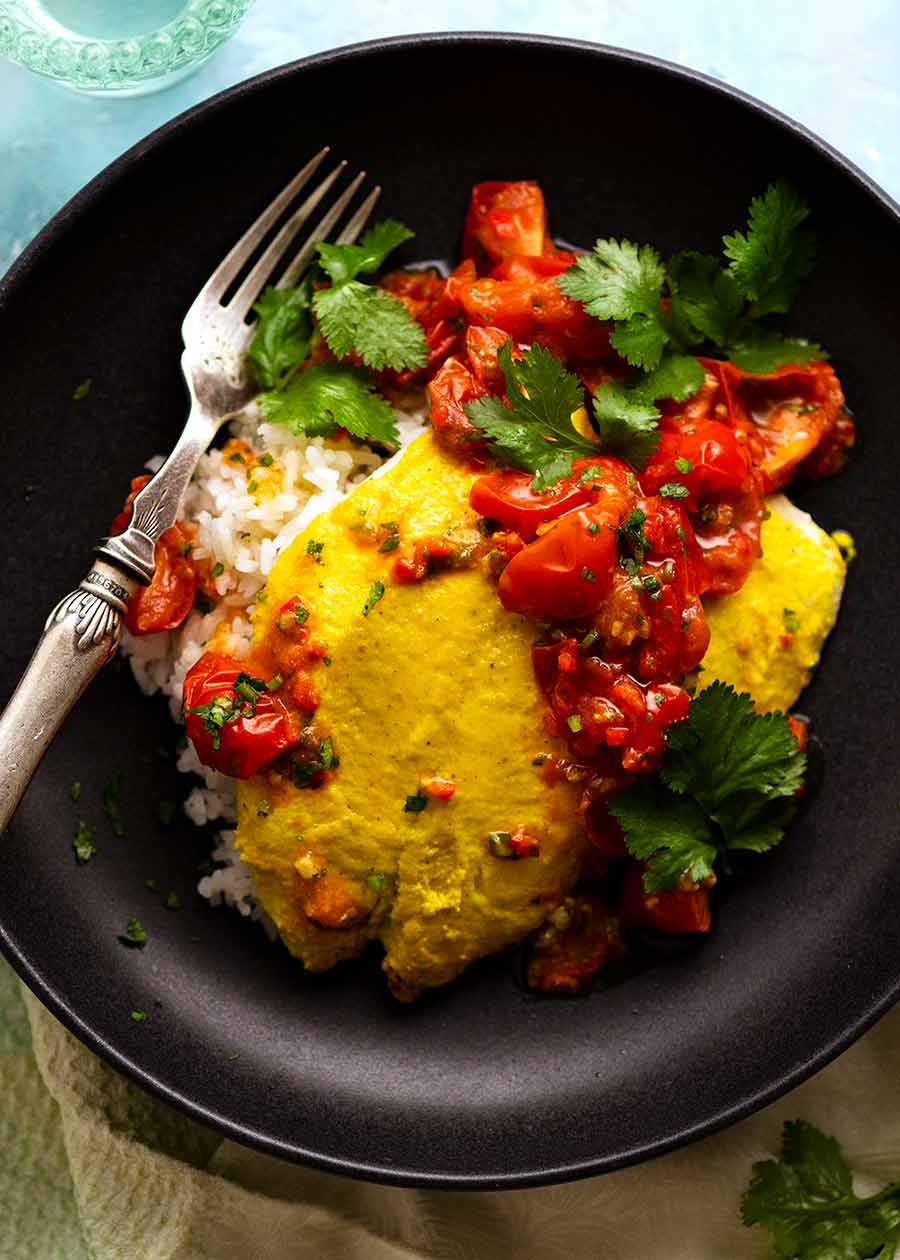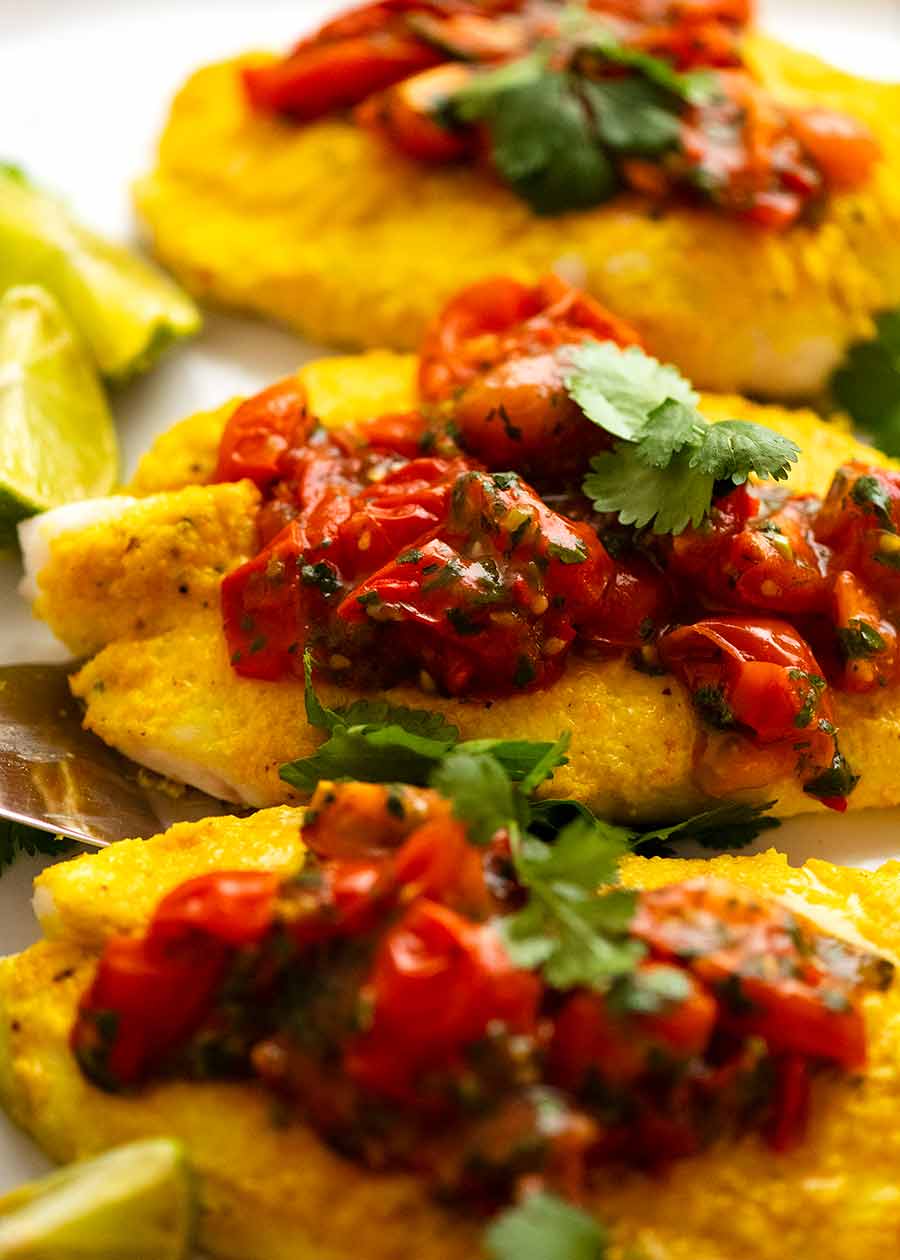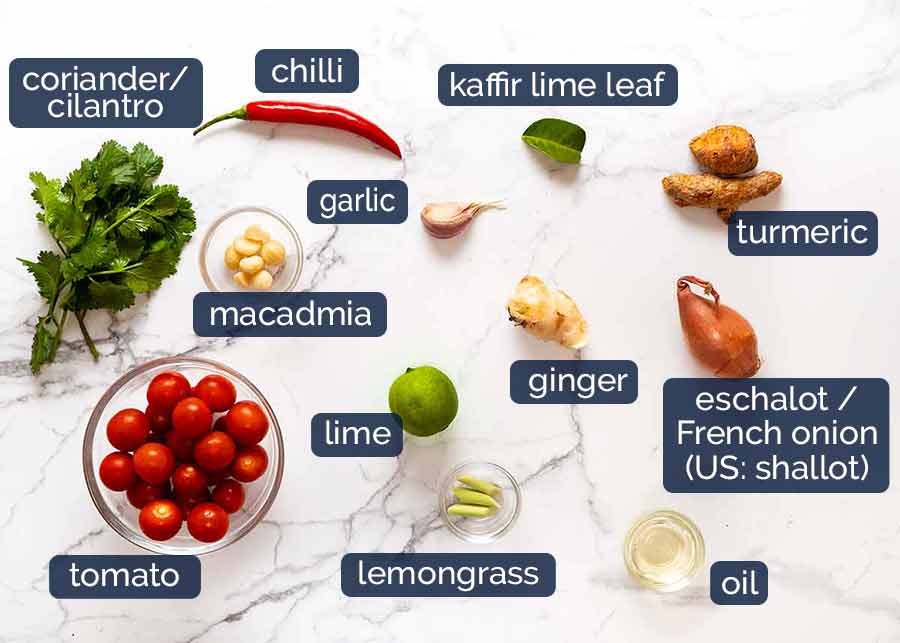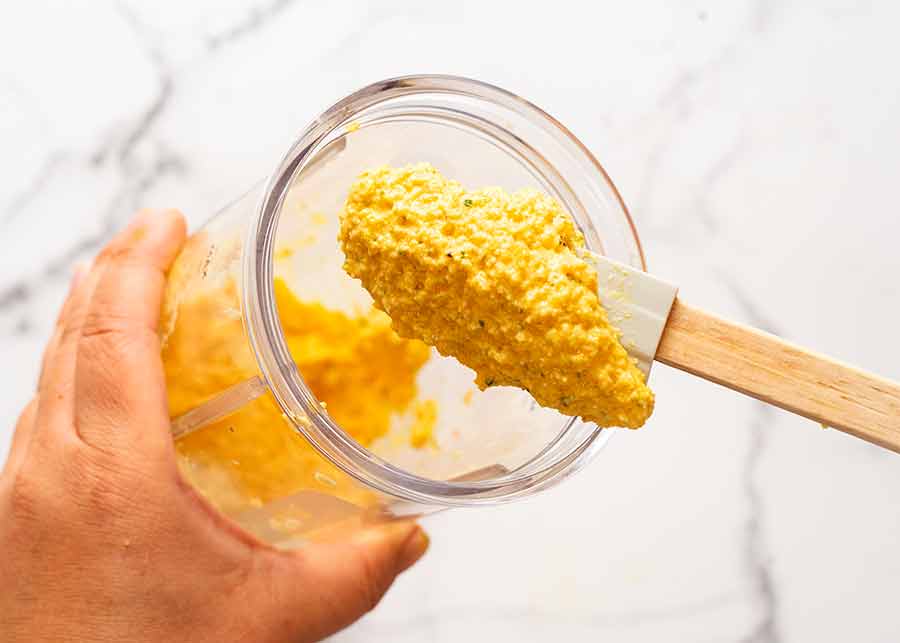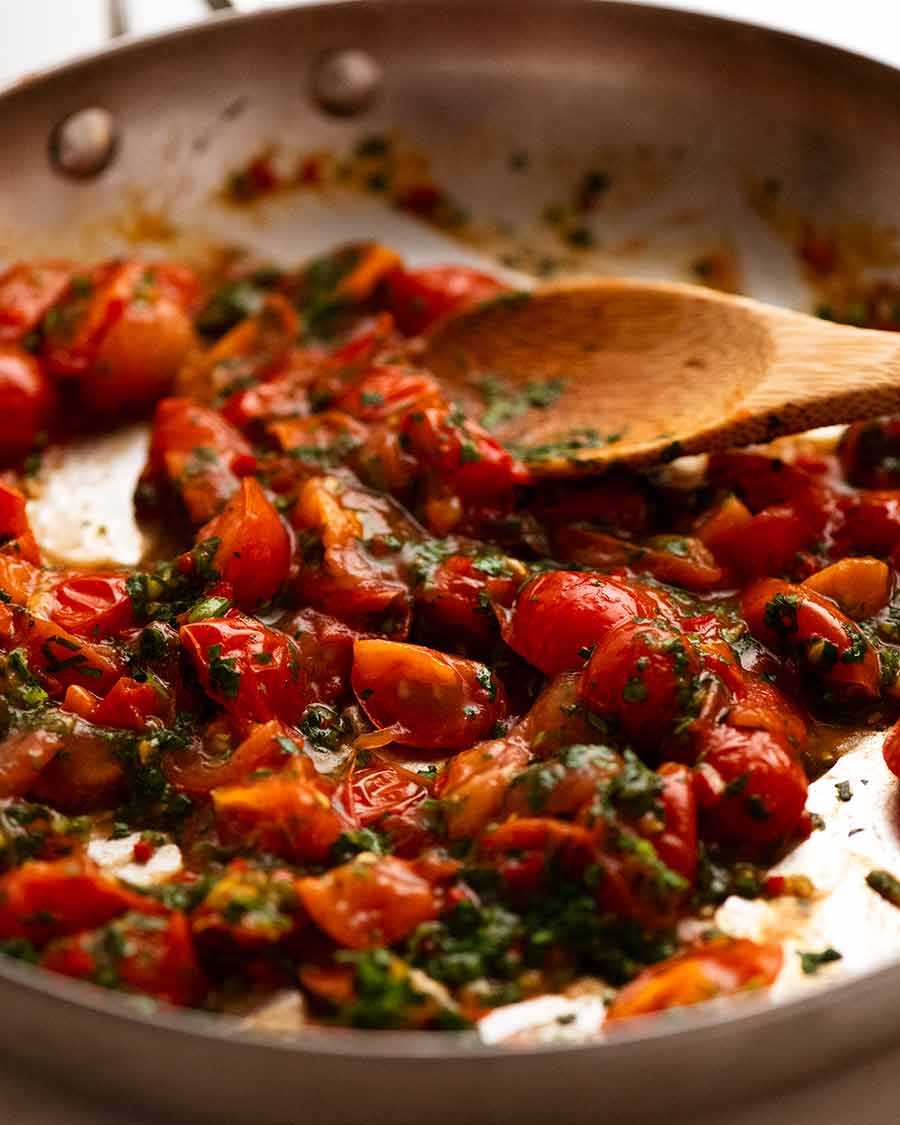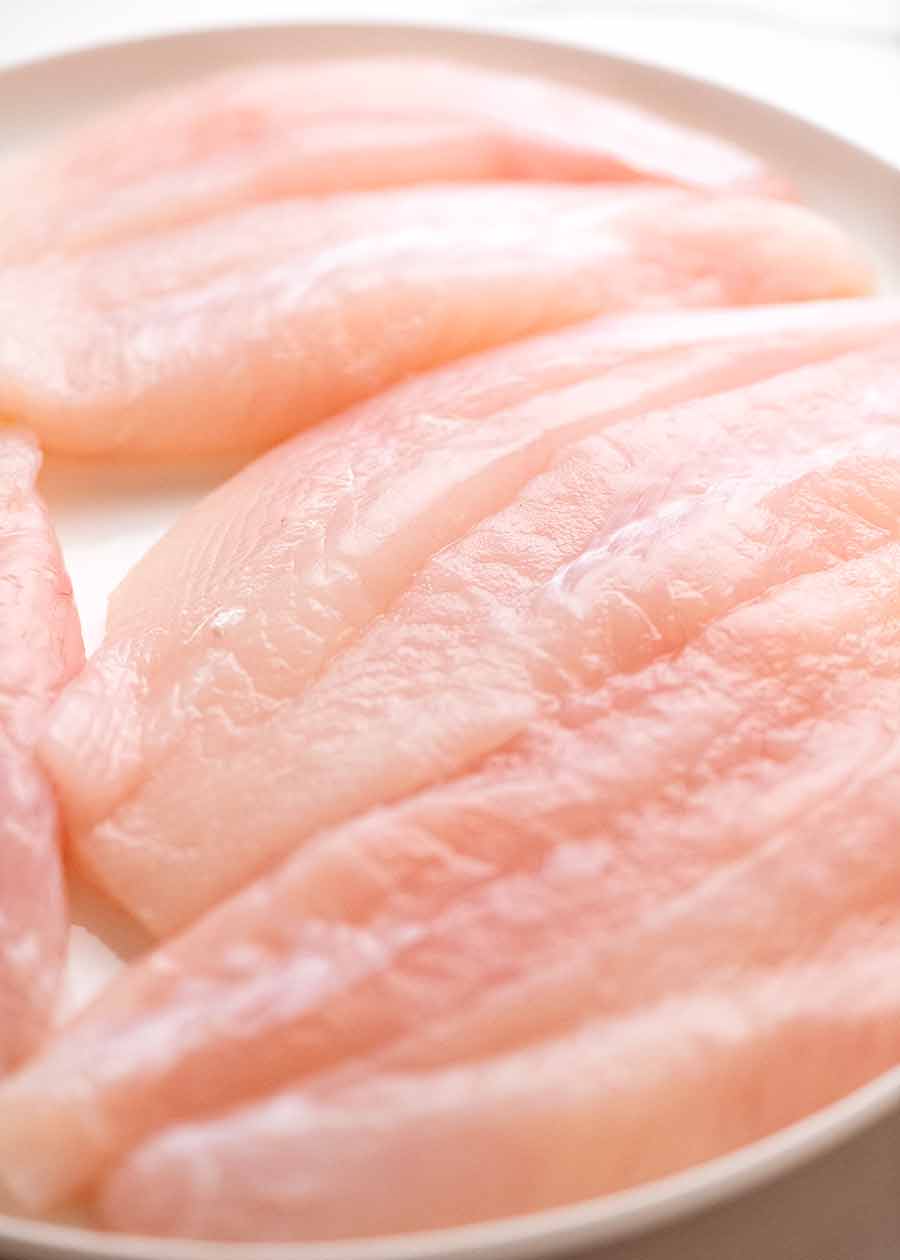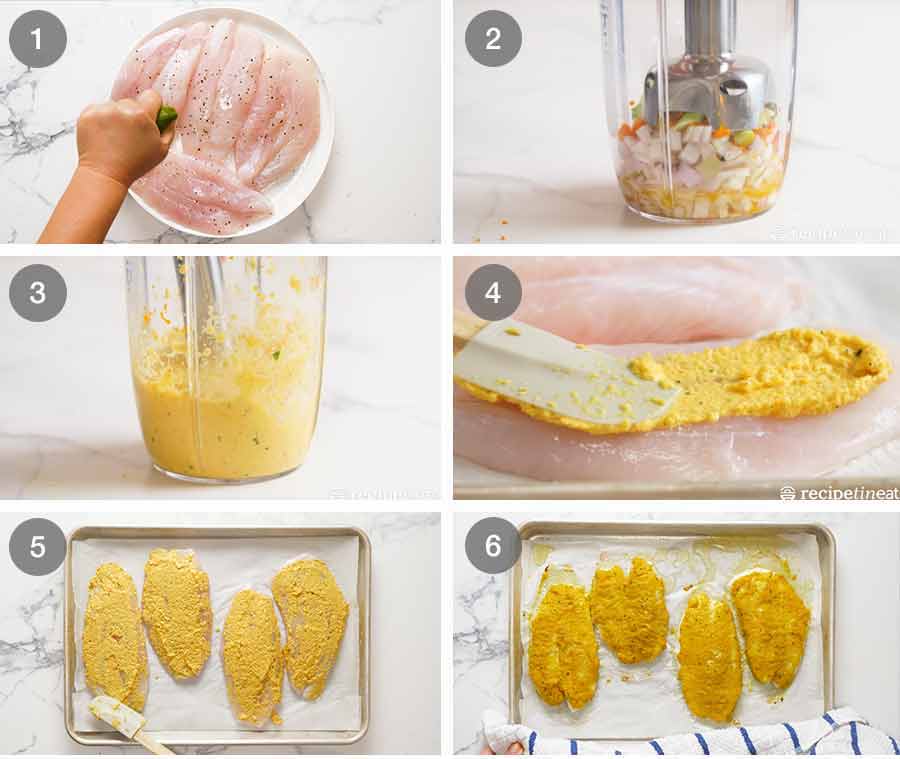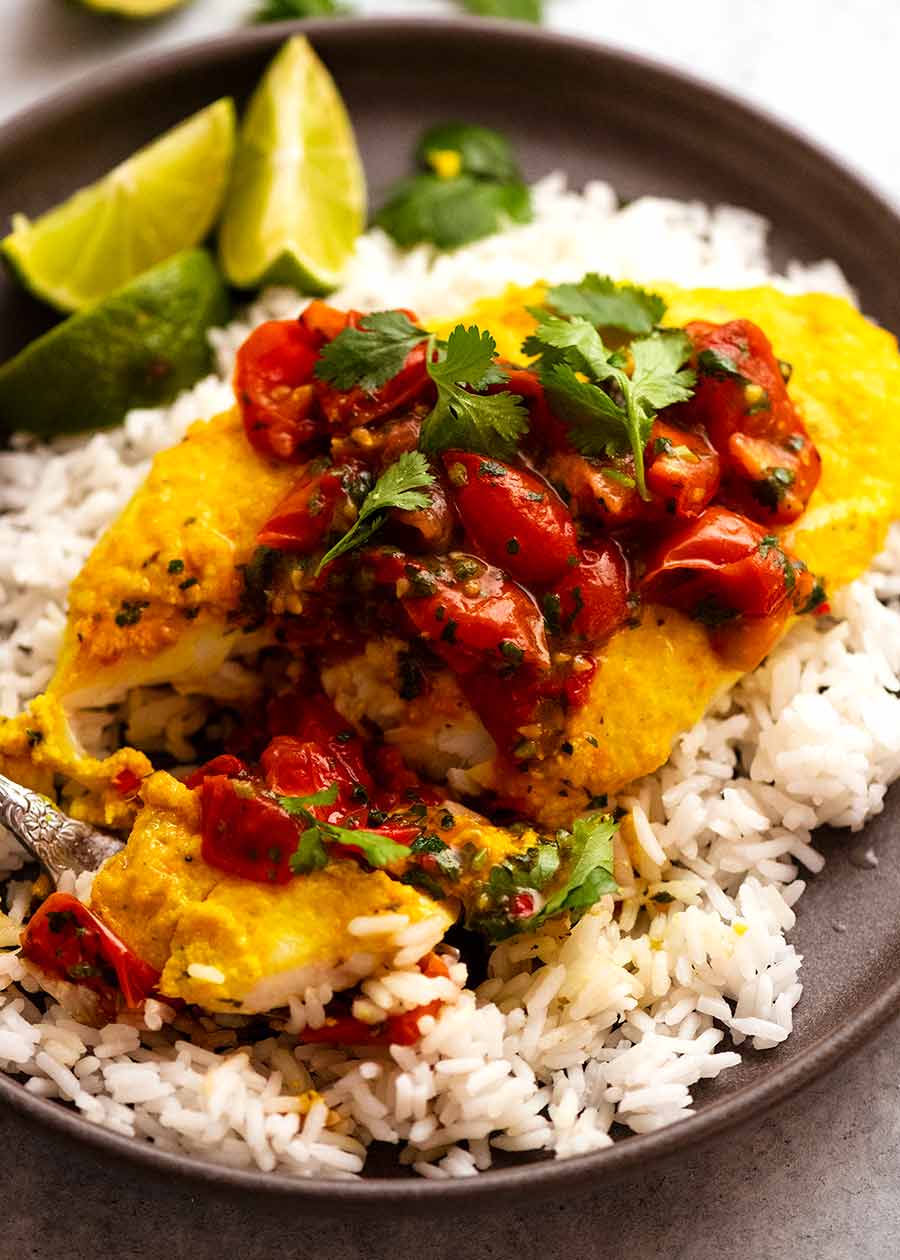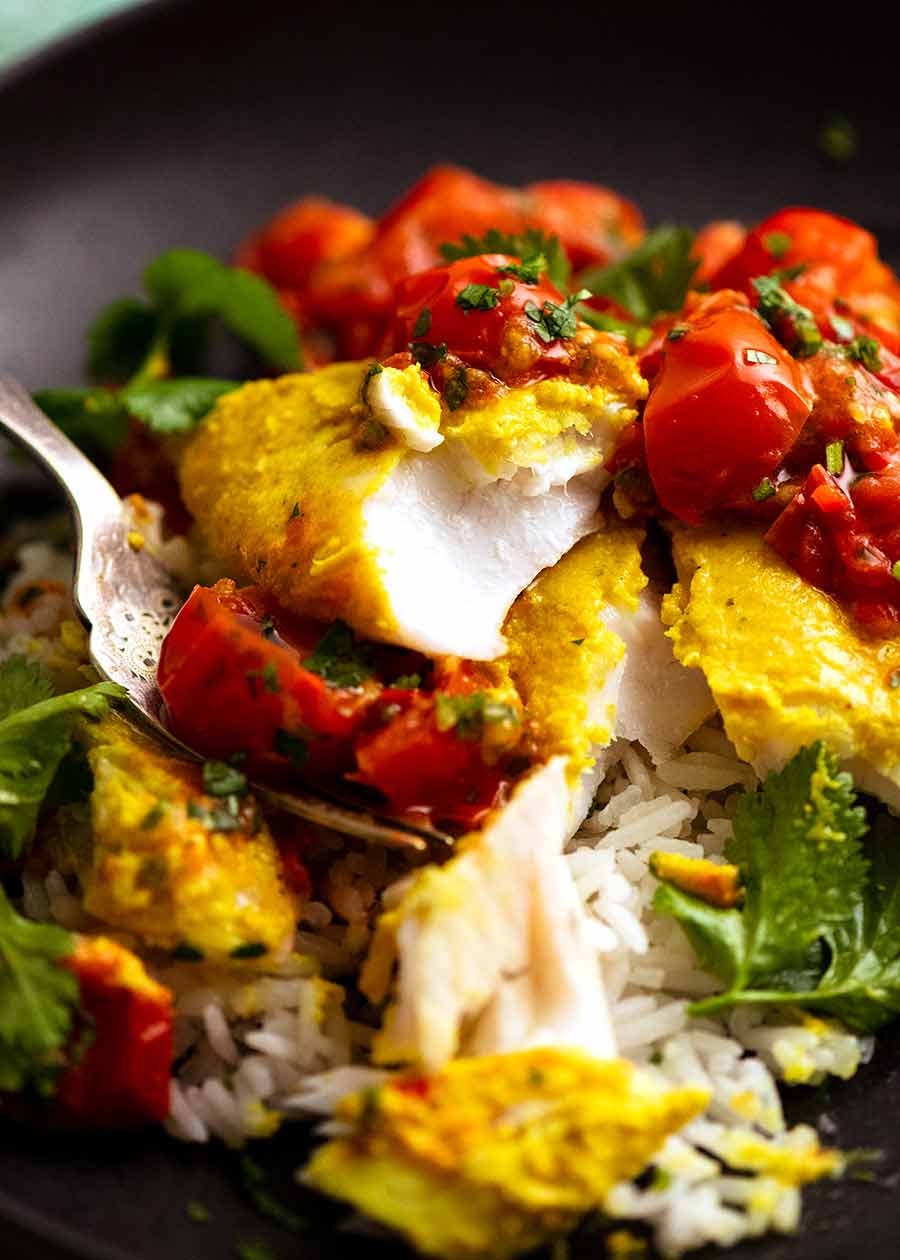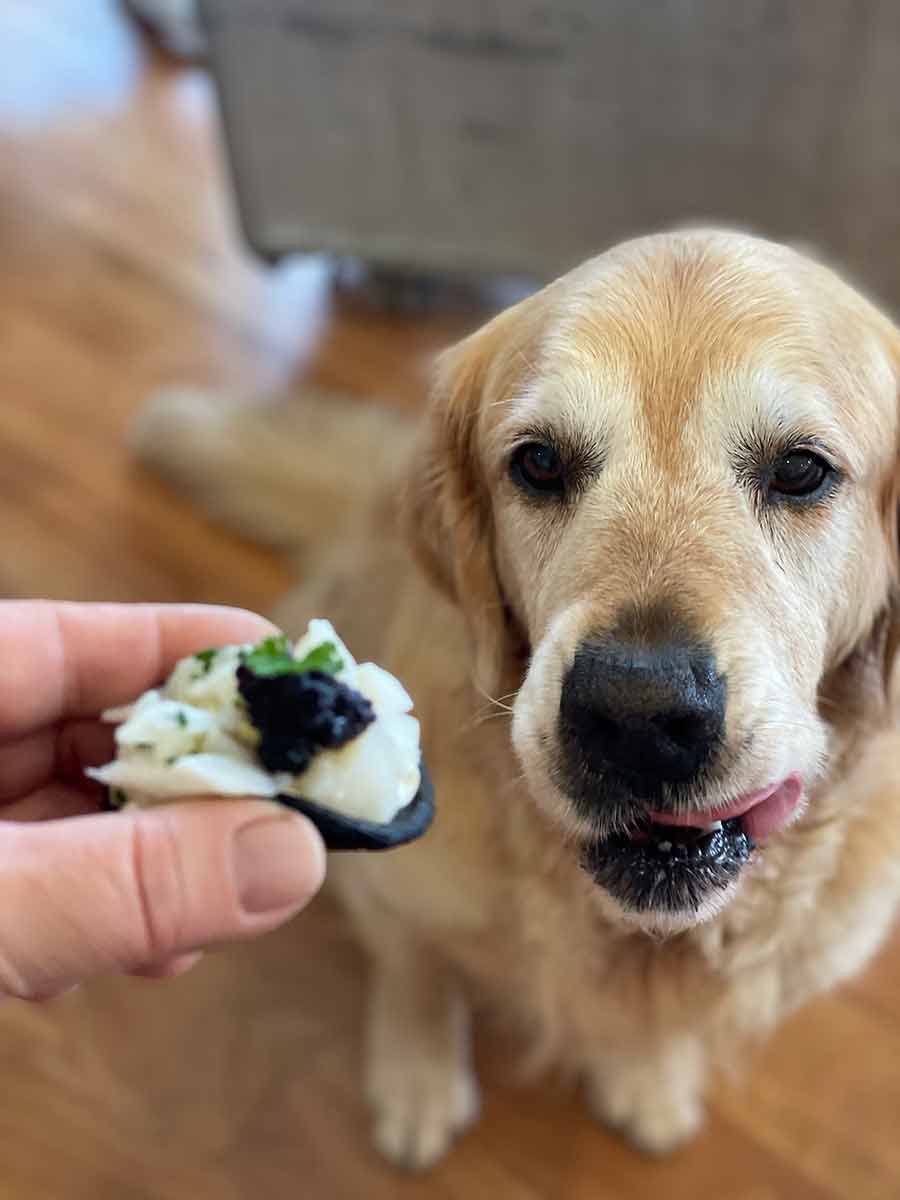A delight to look at and even better to eat, if you love South-East Asian food, this one’s got your name written all over it!
Golden Turmeric Fish
Everybody has heard these days that turmeric is good for you. This golden-coloured spice is reputed to help prevent heart disease, Alzheimer’s, cancer, plus has potent anti-inflammatory and antioxidant properties, to name a few of its benefits. Well, I’d love to tell you that I’m including turmeric into this recipe for health reasons. But I’m not! Turmeric is a fairly common ingredient in South-East Asian cooking (even more so in Indian food!), whether in powdered or fresh form. In today’s recipe, it’s used in a homestyle Indonesian fish dish. Fresh turmeric is the star ingredient in the bright-yellow Indonesian turmeric curry paste which we slather on to fish before baking. To serve, the fish is topped with a simplified Sambal Tomat – think of it as a kind of tomato-based Indonesian “salsa”. The Sambal Tomat adds freshness and juiciness to the overall dish, and really brings the whole dish together. Don’t even think about skipping it, trust me! I love the vibrant colour of the fish, and the striking contrast of the red Sambal Tomat. The looks play second fiddle only to the taste – The fresh curry flavours playing against the bright Sambal Tomat in this are sensational!
Ingredients required for Turmeric Curry Paste & Topping
Here’s what you need to make the:
Turmeric Curry Paste which we slather onto the fish; andfresh Sambal Tomat which is like a salsa that we pile over the fish.
Because there’s a few South East Asian specific ingredients listed above, I’ll do a quick run through of each of them.
Turmeric Curry Paste
Turmeric – The key ingredient in this curry paste that makes it golden! It’s an aromatic fresh spice used in Asian cooking, well known these days for its health benefits (helping in the prevention of heart disease, Alzheimer’s, cancer, plus potent anti-inflammatory and antioxidant). It looks a bit like ginger on the outside, and is bright orange on the inside. The flavour is mild but can actually be quite bitter when eaten by itself. Its primary use in cooking is for healthfulness and for colour.WARNING! It stains so use gloves and avoid porous surfaces once cut. To prepare turmeric, scrape off skin using spoon or vegetable peeler, then grate using a microplane straight into a ceramic bowl. Substitute: Powdered dried turmeric, see recipe notes for details;Kaffir lime leaves are the leaves of a kaffir lime tree. It’s used to add earthy citrus flavours into Asian food, and is sold at large grocery stores (Australia: Coles, Woolies, Harris Farm) and Asian stores. Dried is an ok substitute (same amount), but I really urge you to try to find fresh if you can because it adds that “something-something” that really gives this a “restaurant touch”. Lime leaves freeze 100% perfectly, I always have a stash!Other recipes using Kaffir Lime Leaves: Malaysian Chicken Satay Curry, Tom Yum Soup, Green Curry, Red Curry, Thai Meatballs, Beef Rendang.Ginger and garlic – Essential aromatics present in most South-East Asian curries!Lemongrass – Another popular aromatic used in South East Asian curries and marinades (Thai Red Curry, Vietnamese chicken marinade). It has an addictive, mellow and earthy lemon smell and flavour!To prepare lemongrass, cut off the top half of the stem (it’s too dry). Peel the reedy pale-green layers off the remainder to reveal the softer white part on the bottom half of the lemongrass. Then slice to use in the recipe. If lemongrass is hard to come by, you can use Lemongrass Paste: use 2 teaspoons;Macadamia nuts – These are actually used in place of candlenuts which are used in Indonesian cooking for their very rich oils for things like curry pastes when pureed. Candlenuts actually have a very similar flavour and texture to macadamia nuts, though they are rougher. I used macadamia nuts because they’re readily accessible for me!Substitutions – I hadn’t tried, but confident that sunflower seeds or pepitas will work just fine. It’s not so much about the flavour macadamia nuts add but the oil and texture for the paste which these seeds can also provide;Eschalot – Also known as French onions, and are called “shallots” in the US. They look like baby onions, but have purple-skinned flesh;Oil – We need a touch of oil in the curry paste otherwise it’s too dry; andWater – For adjusting the thickness of the curry paste. It needs to be thin enough so it can be blitzed, but thick enough to slather on like a paste on to the fish.
Sambal Tomat (Indonesian tomato “salsa”)
This might be a simple condiment, but do not underestimate what it brings to this recipe! It really ties the whole dish together, adding freshness and juiciness that compliments the fresh curry flavours on the fish. WARNING! It stains so use gloves and avoid porous surfaces once cut. To prepare turmeric, scrape off skin using spoon or vegetable peeler, then grate using a microplane straight into a ceramic bowl. Substitute: Powdered dried turmeric, see recipe notes for details; Other recipes using Kaffir Lime Leaves: Malaysian Chicken Satay Curry, Tom Yum Soup, Green Curry, Red Curry, Thai Meatballs, Beef Rendang. To prepare lemongrass, cut off the top half of the stem (it’s too dry). Peel the reedy pale-green layers off the remainder to reveal the softer white part on the bottom half of the lemongrass. Then slice to use in the recipe. If lemongrass is hard to come by, you can use Lemongrass Paste: use 2 teaspoons; Substitutions – I hadn’t tried, but confident that sunflower seeds or pepitas will work just fine. It’s not so much about the flavour macadamia nuts add but the oil and texture for the paste which these seeds can also provide;
Cherry tomatoes – Else grape tomatoes, or diced ordinary tomatoes;Chilli – This is a cayenne pepper which is actually not that spicy. It gives the Sambal Tomat a nice hum of warmth. Easy to adjust to your taste – just add less or more; andCoriander/cilantro – A common herb in South-East Asian food which adds wonderful freshness. Alternative: chives (not the same flavour, but will bring another flavour to the salsa).
Fish for Golden Turmeric Fish
I used John Dory in this baked fish recipe. The fillets are thick enough to make them suitable for cooking in the oven and the mild, sweet flavour of the flesh makes it ideal for enhancing with this relatively subtle flavoured curry paste. See below for a list of other suitable fish. Any fairly firm, white fish fillets will work a treat here as long as they are not too thin so they can be baked in the oven! Skin on or off? Either is fine, it really won’t affect the bake time. But the skin won’t be crispy. If this is a turn-off for you, just eat the flesh and leave the skin.
OTHER FISH SUITABLE TO USE
This recipe is suitable for most fish fillets that are around 1.5 – 2.5 cm (0.6 – 1″) thick. We need fillets that are not too thin so it can be baked in the oven for at least 10 minutes so that the curry paste can cook out. Fillets this thick will generally come off medium and larger fish. Here are some suggestions:
BarramundiBasaBreamCod (any)EmperorFlatheadGrouperHalibutHokiJewfish (mulloway)John Dory (pictured in this post)LingMonkfishDeep sea perch (orange roughy)Pollock (aka coley)Salmon and ocean trout – will work but not the best for the type of curry paste (it’s a bit too fresh and light for these stronger-flavoured fish)SnapperStriped bass (not all bass is suitable), gummy sharkTilapia – the thick part (reduce oven cook time to 12 minutes)
Remember, the shape of fish means that you get thick cuts from the main body as well as thin cuts from towards the tail. Opt for the thicker cuts!
FISH TO AVOID
I recommend avoiding:
Fish that dry out easily when cooked – Like swordfish, tuna, bonito, kingfish, marlin, mackerel. Unless you’re extremely careful they can become dry inside so are very prone to overcooking in the oven. I feel these fish are (mostly) better in raw/rare form such as Ceviche, Poke Bowls, Tartare (also see Tuna Steak);Delicate fish, thin-filleted, long very narrow or small fish – Like flounder, sole, plaice, whiting and hake. These fillets are too thin or too long and narrow, or too fragile to cook in the oven using this curry paste. They will either cook too quickly, or the shape is not as suitable for slathering; andOily, “fishy” fish – Like mullet and sardines.
How to make Golden Turmeric Fish
One of the things I really like about this recipe is that it tastes like you’ve put a lot more effort in it than it requires. We’re essentially making our own Turmeric Curry Paste here, yet it’s a simple dump-and-blitz job!
If you don’t have a meat thermometer, check to see the flesh flakes easily at the thickest point, which indicates the fish is done;
What to serve with Golden Turmeric Fish
It’s pictured served over Jasmine Rice (I think… possibly just normal white rice!). You’ll find the combination of the curry paste, the juicy flesh of the fish and the tomato salsa topping kind of mixes through the rice adding plenty of flavour so you don’t miss a sauce to douse the plain rice with. Here are some rice options for you (even a faux-rice!):
White riceJasmine riceBasmati riceBrown riceCauliflower rice (low carb)
And though the Sambal Tomat Topping adds a bit of vegetable to the plate, for a little extra, try one of these:
Smashed Cucumber SaladAsian Slaw – healthy, crunchy Asian Cabbage SaladAustralia’s favourite salad? Chang’s Crispy Noodle Salad!
Enjoy! – Nagi x
Watch how to make it
Life of Dozer
When Dozer was faced with a Lobster Blini…. Do you think he got a taste test….??
